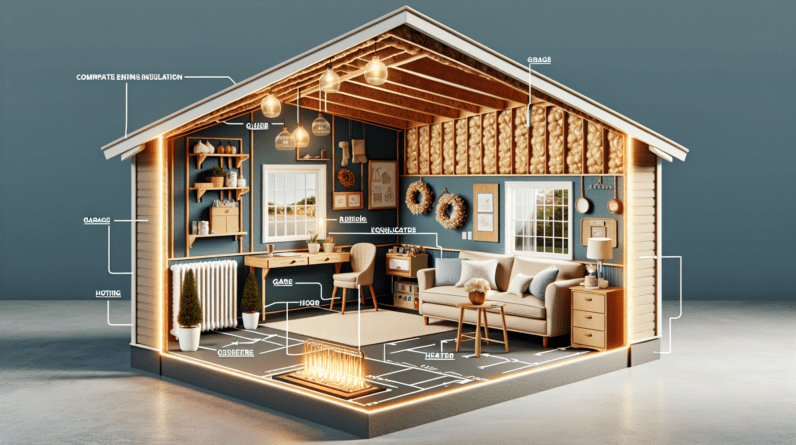
Are you considering converting your garage into a guest room? This article will provide you with valuable information on how to navigate zoning and permits for garage conversions. The process can seem daunting, but with the right knowledge and preparation, you can transform your garage into a functional and comfortable space for your guests. Throughout this article, we will share research-based insights and practical tips to help you successfully navigate the zoning and permit requirements for this exciting home improvement project. Get ready to create a welcoming and cozy guest room that will impress your visitors.

Understanding Zoning Regulations
Zoning regulations play a crucial role in shaping the development and land use within a specific area. By understanding these regulations, you can ensure that your construction project complies with the local requirements. There are various types of zoning regulations that you should be aware of to avoid any legal issues or setbacks during the construction process.
Types of Zoning Regulations
Zoning regulations typically categorize different types of land use into designated zones. These zones can include residential, commercial, industrial, agricultural, and mixed-use areas. Each zone has its own set of rules and restrictions that dictate the type of structures, activities, and uses allowed within that zone. It’s important to familiarize yourself with the zoning classification of your property to understand what is permitted and what is not.
Specific Requirements for Residential Properties
When it comes to residential properties, zoning regulations often have specific requirements that need to be met. These requirements can include setbacks from property lines, minimum lot sizes, maximum building heights, and provisions for open spaces. Additionally, there may be regulations regarding the number of allowed dwelling units, parking spaces, or other architectural considerations. Consulting the local zoning code or contacting the local zoning department can help you understand the specific requirements for your residential property.
Restrictions on Garage Conversions
Garage conversions have gained popularity in recent years as a way to maximize living space. However, zoning regulations may impose certain restrictions on these conversions. Some areas might require a minimum number of parking spaces to be maintained, while others may have limitations on the size or purpose of the converted space. It’s crucial to research and understand these restrictions before embarking on a garage conversion project to ensure compliance with the zoning regulations.
Researching Local Zoning Laws
To navigate the complex world of zoning and permits, it is essential to conduct thorough research and become well-informed about the local regulations that apply to your property. This research process involves reaching out to the local zoning department, reviewing the zoning code, and checking for any special regulations that may be in place.
Contacting the Local Zoning Department
The local zoning department is your primary resource for information on zoning regulations. They can provide valuable insights into the specific requirements for your property, answer questions related to zoning codes, and clarify any doubts you may have. By contacting this department, you can gain a clear understanding of what is permitted and what isn’t concerning your construction project.
Reviewing the Zoning Code
The zoning code is a comprehensive document that outlines the rules and regulations for land use in a particular area. Reviewing the zoning code is essential to familiarize yourself with the specific requirements and restrictions that apply to your property. This code details the different zoning districts, land use regulations, and any additional guidelines that govern construction within the area. Take your time to carefully read and understand the zoning code to ensure compliance with all the necessary regulations.
Checking for Special Regulations in Your Area
Apart from the general zoning code, it is crucial to check for any special regulations that may exist within your area. These special regulations can include historic preservation guidelines, environmentally sensitive area restrictions, or regulations specific to a particular neighborhood. These additional regulations may have an impact on your construction project, so it’s important to be aware of them and adjust your plans accordingly.
Determining Permit Requirements
Obtaining the necessary permits is a key aspect of managing a construction project. To determine the permit requirements for your specific project, you need to identify whether permits are needed, understand the types of permits required, and become familiar with the application process.
Identifying the Need for Permits
Not all construction projects require permits, but many do. It is essential to identify whether your project falls within the scope of needing permits. Common examples of projects that typically require permits include new construction, additions, remodeling, and changes in land use or occupancy. Identifying the need for permits will save you from facing potential legal issues or penalties down the line.
Types of Permits Required
Different types of permits may be required depending on the nature of your construction project. Examples include building permits, electrical permits, plumbing permits, and mechanical permits. Building permits typically cover structural changes, while electrical permits are necessary for any electrical work. Plumbing permits are required for plumbing modifications, and mechanical permits cover HVAC installations and modifications. Understanding the specific permits required for your project will help ensure that you comply with the necessary regulations.
Understanding the Application Process
Once you have determined the need for permits and identified the specific types required, it’s important to familiarize yourself with the application process. Each permit type may have different application requirements and processes. Understanding the application process will help you gather the necessary documents, fill out the application forms correctly, and streamline the overall permit acquisition process. Contacting the local permitting department or visiting their website will provide you with detailed information on the application process specific to your area.
Meeting Building Codes
Building codes are sets of regulations that establish the minimum standards for construction to ensure safety and habitability. Compliance with building codes is an essential aspect of any construction project. Familiarizing yourself with the minimum requirements for habitable spaces, safety and structural considerations, as well as electrical, plumbing, and HVAC standards, is crucial to ensure your project meets all necessary codes.
Minimum Requirements for Habitable Spaces
To ensure habitable spaces are safe and meet minimum standards, building codes typically cover various aspects such as room sizes, ceiling heights, natural lighting, ventilation, and egress requirements. Room sizes need to be adequate for their designated use, while ceiling heights must meet a minimum height requirement to ensure comfort and accessibility. Proper natural lighting and ventilation are essential for healthy living environments. Egress requirements dictate the number, location, and size of exits to ensure occupants can safely exit the building in case of an emergency.
Safety and Structural Considerations
Building codes encompass safety and structural considerations to prevent accidents, structural failures, and ensure overall stability. These considerations include regulations on fire resistance, structural load capacities, foundations, stairs, railings, and handrails. Fire resistance provisions aim to limit the spread of fire, providing occupants with precious time to evacuate the building safely. Structural load capacities account for the maximum weight a structure can support without compromising safety. Regulations on foundations, stairs, railings, and handrails ensure stability and safety throughout the building.
Electrical, Plumbing, and HVAC Standards
Electrical, plumbing, and HVAC systems are crucial for the functionality and safety of a building. Building codes establish standards regarding the installation, materials, and safety features of these systems. Electrical codes cover wiring, outlets, switches, grounding, and circuit breaker requirements to prevent electrical hazards. Plumbing codes specify the proper installation of pipes, fixtures, and drainage systems to ensure efficient water supply and waste removal. HVAC standards ensure safe and proper installation, operation, and maintenance of heating, ventilation, and air conditioning systems to maintain indoor comfort and air quality.
Working with Contractors and Design Professionals
Constructing or renovating any structure involves collaboration with contractors and design professionals to bring your vision to life. It’s crucial to hire experienced professionals, obtain detailed floor plans and designs, and ensure their compliance with the applicable regulations to ensure a successful and compliant construction project.
Hiring Experienced Professionals
Working with experienced professionals, such as architects, engineers, and contractors, is essential to ensure your project is designed and executed correctly. Experienced professionals possess the necessary knowledge and expertise to navigate the complexities of zoning regulations, building codes, and permit requirements. They can guide you through the entire process, provide valuable advice, and help you avoid potential pitfalls. Researching and hiring professionals with a proven track record in your specific project type will increase the likelihood of a successful outcome.
Obtaining Detailed Floor Plans and Designs
Detailed floor plans and designs are essential for accurate construction and permit documentation. Architects and designers create these plans, considering all necessary regulations, spatial requirements, and functionality. The plans should clearly indicate the layout, dimensions, materials, and finishes of the proposed construction or renovation. Obtaining detailed floor plans and designs not only helps ensure compliance with zoning regulations and building codes but also assists in the permit application process.
Ensuring Compliance with Regulations
When working with contractors and design professionals, it is crucial to ensure that the proposed plans and designs comply with all applicable regulations. The professionals should have a thorough understanding of local zoning laws and building codes. Regular communication and collaboration with your team will help identify and address any potential compliance issues early on, minimizing project delays, and ensuring your construction project meets the necessary regulations.
Preparing Documentation
Proper documentation is essential throughout the construction process. It helps ensure that all aspects of your project comply with zoning regulations, building codes, and permit requirements. When preparing documentation, you should focus on creating accurate project plans, gathering necessary supporting documents, and completing permit applications accurately.
Creating Accurate Project Plans
Accurate project plans are the foundation of a successful construction project. These plans should include detailed architectural, structural, electrical, plumbing, and HVAC drawings that conform to the requirements outlined in the zoning regulations and building codes. Creating accurate project plans in collaboration with design professionals will help you obtain the necessary permits and avoid potential issues during construction.
Gathering Necessary Supporting Documents
Supporting documentation is crucial to demonstrate compliance with zoning regulations and building codes. This documentation can include structural calculations, energy efficiency reports, fire safety plans, environmental impact assessments, and any other supporting materials that may be required for your specific project. Gathering all necessary supporting documents ensures that your construction project is well-documented, compliant with regulations, and helps expedite the review process.
Completing Permit Applications
Completing permit applications accurately and thoroughly is essential to avoid delays or rejections. Permit applications typically require detailed information about the project, including project plans, property information, contractor details, and the specific permits being requested. Double-checking the application forms for completeness, accuracy, and signature requirements is crucial. Additionally, make sure to adhere to any specific instructions provided by the permitting department to ensure a smooth application process.
Submitting Permit Applications
Submitting permit applications is a crucial step in the construction process. Filling out the application forms, paying required fees, and delivering the application to the appropriate department are essential to initiate the review process and obtain the necessary permits.
Filling out Application Forms
When filling out application forms, ensure that all the required information is provided accurately and completely. Missing or incorrect information can delay the review process or result in the rejection of the application. Pay close attention to any specific requirements or attachments mentioned in the application forms and include them as necessary. Taking the time to ensure the application forms are correctly filled out will help streamline the permit approval process.
Paying the Required Fees
Most permit applications come with associated fees. These fees cover the costs involved in reviewing and processing the application. It’s important to check the local regulations or contact the permitting department to determine the exact amount of fees required for your project. Make sure to include the correct fee payment with your permit application to avoid any delays in processing.
Submitting the Application to the Appropriate Department
After completing the application forms and paying the required fees, it’s time to submit the application to the appropriate department. This can typically be done in person or through an online portal if available. Ensure that you submit the application to the correct department responsible for permits and zoning to avoid any unnecessary delays or complications. Keep a copy of all submitted documents for your records.
Navigating the Permit Approval Process
After submitting your permit application, it undergoes a review process to ensure compliance with zoning regulations and building codes. Understanding this process, addressing any issues or concerns that arise, and eventually receiving final permit approval are important steps in bringing your construction project to life.
Understanding the Review Process
The review process involves a thorough evaluation of your permit application by various departments or individuals, such as code enforcement officers, engineers, fire marshals, and zoning officials. They assess the proposed plans and documents to ensure compliance with zoning regulations and building codes. Review times can vary depending on the complexity of the project and the workload of the reviewing officials. However, it is common for the reviewing department to provide an estimated timeline for completion of the review.
Addressing Any Issues or Concerns
During the review process, it is possible that the reviewing officials may identify issues or concerns with your permit application or project plans. It is important to promptly address any issues or concerns raised by the reviewing department. This may involve providing additional information, making necessary revisions to project plans, or addressing any non-compliance. Maintaining open lines of communication and working closely with the reviewing officials will help ensure that any issues are resolved quickly and efficiently.
Receiving Final Permit Approval
Once all issues and concerns have been addressed to the satisfaction of the reviewing officials, you will receive final permit approval. This approval indicates that your construction project has met all the necessary requirements and complies with the applicable regulations. With final permit approval in hand, you can proceed with confidence, knowing that your project has been thoroughly reviewed and has obtained the necessary permissions to proceed.
Managing Construction and Inspections
After obtaining the required permits, managing construction and coordinating inspections are crucial to ensuring the successful completion of your project. Following building codes and regulations, scheduling construction work, and coordinating inspections at various stages are essential throughout the construction process.
Scheduling Construction Work
Scheduling construction work involves planning and coordinating the activities and timelines of various contractors and tradespeople involved in your construction project. It is important to create a detailed schedule that takes into account the sequence of work, availability of materials, and coordination between different parties. Adhering to the approved project plans, building codes, and other applicable regulations is vital to ensure a smooth construction process.
Coordinating Inspections at Various Stages
Inspections are an integral part of the construction process and ensure that the work is being done according to approved plans and relevant regulations. Inspections typically occur at various stages of the project, such as foundation, framing, electrical, plumbing, and final inspections. Coordinating with the local building department to schedule inspections at the appropriate stages is crucial. It is important to ensure that all work meets the necessary requirements before proceeding to the next phase of construction.
Adhering to Building Codes and Regulations
Throughout the construction process, it is important to adhere to building codes and regulations to maintain compliance and ensure the safety and quality of the completed structure. This includes following the approved project plans, using approved materials and construction methods, and addressing any deficiencies identified during inspections. Regular communication and collaboration with contractors, design professionals, and the local building department will help ensure that all work meets the necessary standards and regulations.
Ensuring Occupancy Compliance
Once construction is complete, ensuring occupancy compliance is the final step before your project can be inhabited. Securing a Certificate of Occupancy, understanding occupancy restrictions, and maintaining compliance with zoning regulations are essential to ensure the lawful use and occupation of the structure.
Securing a Certificate of Occupancy
A Certificate of Occupancy is an official document issued by the local building department that states a building is safe for occupancy and compliant with all relevant regulations. To obtain a Certificate of Occupancy, a final inspection is typically conducted to verify that the construction has been completed in accordance with the approved plans and building codes. Once the final inspection is passed, the local building department will issue the Certificate of Occupancy, allowing you to legally occupy the structure.
Understanding Occupancy Restrictions
Zoning regulations often dictate occupancy restrictions for different types of buildings or structures. These restrictions can include limitations on the number of occupants, the type of activity allowed, or the specific use of the space. It is important to understand and comply with these occupancy restrictions to ensure you are using the structure within the bounds of the law.
Maintaining Compliance with Zoning Regulations
Even after receiving a Certificate of Occupancy, it is essential to continue maintaining compliance with zoning regulations. These regulations may impose ongoing requirements, such as property maintenance standards, signage limitations, or restrictions on future alterations or expansions. Regularly reviewing and adhering to these regulations will help ensure that you remain in compliance with the law and avoid any potential penalties or legal issues.
In conclusion, navigating zoning regulations and permits for any construction project can be challenging but crucial for successful and compliant outcomes. By understanding the types of zoning regulations, researching local zoning laws, determining permit requirements, meeting building codes, working with professionals, preparing documentation, submitting permit applications, navigating the approval process, managing construction and inspections, and ensuring occupancy compliance, you can navigate the complex world of zoning and permits with confidence. Remember, always consult the local authorities and professionals for specific advice and requirements related to your project.






